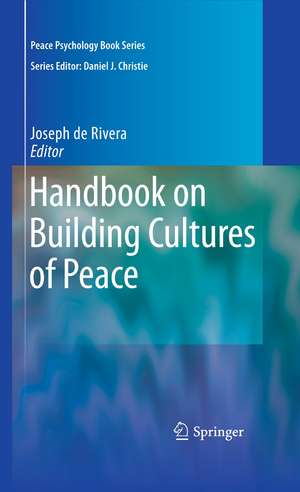Handbook on Building Cultures of Peace: Peace Psychology Book Series
Editat de Joseph de Riveraen Limba Engleză Paperback – 12 noi 2011
| Toate formatele și edițiile | Preț | Express |
|---|---|---|
| Paperback (1) | 1222.94 lei 6-8 săpt. | |
| Springer – 12 noi 2011 | 1222.94 lei 6-8 săpt. | |
| Hardback (1) | 1228.29 lei 6-8 săpt. | |
| Springer – 10 noi 2008 | 1228.29 lei 6-8 săpt. |
Din seria Peace Psychology Book Series
- 18%
 Preț: 779.26 lei
Preț: 779.26 lei -
 Preț: 361.07 lei
Preț: 361.07 lei - 15%
 Preț: 639.25 lei
Preț: 639.25 lei - 18%
 Preț: 788.54 lei
Preț: 788.54 lei - 15%
 Preț: 699.28 lei
Preț: 699.28 lei - 15%
 Preț: 646.62 lei
Preț: 646.62 lei - 18%
 Preț: 1690.13 lei
Preț: 1690.13 lei - 15%
 Preț: 645.28 lei
Preț: 645.28 lei - 24%
 Preț: 1044.87 lei
Preț: 1044.87 lei - 18%
 Preț: 945.14 lei
Preț: 945.14 lei - 15%
 Preț: 649.54 lei
Preț: 649.54 lei -
 Preț: 386.39 lei
Preț: 386.39 lei - 15%
 Preț: 697.82 lei
Preț: 697.82 lei - 15%
 Preț: 591.14 lei
Preț: 591.14 lei - 15%
 Preț: 644.82 lei
Preț: 644.82 lei - 15%
 Preț: 649.22 lei
Preț: 649.22 lei - 15%
 Preț: 697.65 lei
Preț: 697.65 lei -
 Preț: 388.72 lei
Preț: 388.72 lei - 15%
 Preț: 647.08 lei
Preț: 647.08 lei - 24%
 Preț: 967.03 lei
Preț: 967.03 lei - 15%
 Preț: 638.89 lei
Preț: 638.89 lei - 15%
 Preț: 650.37 lei
Preț: 650.37 lei - 18%
 Preț: 733.15 lei
Preț: 733.15 lei -
 Preț: 398.74 lei
Preț: 398.74 lei - 15%
 Preț: 644.30 lei
Preț: 644.30 lei - 18%
 Preț: 1116.57 lei
Preț: 1116.57 lei -
 Preț: 365.05 lei
Preț: 365.05 lei - 15%
 Preț: 643.99 lei
Preț: 643.99 lei - 18%
 Preț: 1116.26 lei
Preț: 1116.26 lei - 18%
 Preț: 1381.26 lei
Preț: 1381.26 lei - 18%
 Preț: 1595.75 lei
Preț: 1595.75 lei - 18%
 Preț: 779.89 lei
Preț: 779.89 lei
Preț: 1222.94 lei
Preț vechi: 1491.38 lei
-18% Nou
Puncte Express: 1834
Preț estimativ în valută:
234.04€ • 243.44$ • 193.21£
234.04€ • 243.44$ • 193.21£
Carte tipărită la comandă
Livrare economică 15-29 aprilie
Preluare comenzi: 021 569.72.76
Specificații
ISBN-13: 9781441918666
ISBN-10: 1441918663
Pagini: 428
Ilustrații: XVIII, 407 p.
Dimensiuni: 155 x 235 x 22 mm
Greutate: 0.59 kg
Ediția:2009
Editura: Springer
Colecția Springer
Seria Peace Psychology Book Series
Locul publicării:New York, NY, United States
ISBN-10: 1441918663
Pagini: 428
Ilustrații: XVIII, 407 p.
Dimensiuni: 155 x 235 x 22 mm
Greutate: 0.59 kg
Ediția:2009
Editura: Springer
Colecția Springer
Seria Peace Psychology Book Series
Locul publicării:New York, NY, United States
Public țintă
Professional/practitionerDescriere
Mediation and negotiation, personal transformation, non-violent struggle in the community and the world: these behaviors—and their underlying values—underpin the United Nations’ definition of a culture of peace, and are crucial to the creation of such a culture. The Handbook on Building Cultures of Peace addresses this complex and daunting task by presenting an accessible blueprint for this development. Its perspectives are international and interdisciplinary, involving the developing as well as the developed world, with illustrations of states and citizens using peace-based values to create progress on the individual, community, national, and global levels. The result is both realistic and visionary, a prescription for a secure future.
A sampling of topics covered in the Handbook:
A sampling of topics covered in the Handbook:
- Basic components of a culture of peace (including education, tolerance, gender equality, human rights, and sustainable development), and how each strengthens the whole.
- The politics and socioeconomics of a culture of peace.
- The relationship of personal to cultural change.
- Applying peace concepts in the law enforcement, justice, and prison systems.
- Community reconciliation and post-conflict reconstruction.
- Achieving peace in the family.
- Assessing—and learning from—modern cultures of peace.
Cuprins
Views from the Social Sciences.- Learning from Extant Cultures of Peace.- Political Economy of Peace.- War in Peace: Cultural Regulation of the Construction-Destruction Dynamic.- Culture Change: A Practical Method with a Theoretical Basis.- The Paradigm Challenge of Political Science: Delegitimizing the Recourse to Violence.- Assessing the Peacefulness of Cultures.- Building the Eight Bases for a Culture of Peace.- Peace Education: Its Nature, Nurture and the Challenges It Faces.- Gender Equality and a Culture of Peace.- Social Cohesion and Tolerance for Group Differences.- Democratic Participation.- Open Communication.- Human Rights and Peacebuilding.- International Security.- Sustainable Development.- Tools for Building Cultures of Peace.- Nonviolent Action, Trust and Building a Culture of Peace.- Negotiation and the Shadow of Law.- Deliberate Dialogue.- Restorative Justice and Prison Reform.- Police Oversight.- Personal Transformations Needed for Cultures of Peace.- Achieving Peace in the Family.- Participatory Approaches to Community Change: Building Cooperation through Dialogue and Negotiation Using Participatory Rural Appraisal.- Community Reconciliation and Post-Conflict Reconstruction for Peace.- Reconciliation as a Foundation of Culture of Peace.- Using the Tools to Build the UN Bases.
Notă biografică
Joseph de Rivera is Professor of Psychology and Director of the Peace Studies Program at Clark University. He attended Bowdoin College, graduated from Yale, served in the Navy Medical Service Corps, and received his doctorate from Stanford University. His area of research focuses on the experience of nuclear weapons, peace fairs, and the emotional motivation of righteous behavior.
Textul de pe ultima copertă
Mediation and negotiation, personal transformation, non-violent struggle in the community and the world: these behaviors—and their underlying values—underpin the United Nations’ definition of a culture of peace, and are crucial to the creation of such a culture. The Handbook on Building Cultures of Peace addresses this complex and daunting task by presenting an accessible blueprint for this development. Its perspectives are international and interdisciplinary, involving the developing as well as the developed world, with illustrations of states and citizens using peace-based values to create progress on the individual, community, national, and global levels. The result is both realistic and visionary, a prescription for a secure future.
A sampling of topics covered in the Handbook:
A sampling of topics covered in the Handbook:
- Basic components of a culture of peace (including education, tolerance, gender equality, human rights, and sustainable development), and how each strengthens the whole.
- The politics and socioeconomics of a culture of peace.
- The relationship of personal to cultural change.
- Applying peace concepts in the law enforcement, justice, and prison systems.
- Community reconciliation and post-conflict reconstruction.
- Achieving peace in the family.
- Assessing—and learning from—modern cultures of peace.
Caracteristici
Interdisciplinary and international analysis that includes economically developed and underdeveloped nations
Chapter authors discuss and formulate the ideas presented in the book to address how cultures of peace may be established and addressed
Sections and chapters were based on a systematic review of best practices from a multicultural perspective that may be applicable to personal, small group, community, national, and global cultures of peace
Includes supplementary material: sn.pub/extras
Chapter authors discuss and formulate the ideas presented in the book to address how cultures of peace may be established and addressed
Sections and chapters were based on a systematic review of best practices from a multicultural perspective that may be applicable to personal, small group, community, national, and global cultures of peace
Includes supplementary material: sn.pub/extras









